Bangladesh At Risk
Climate Change
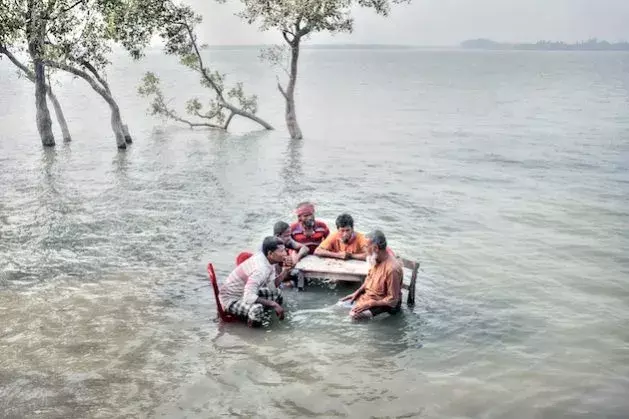
Bangladesh, a picturesque land of rivers, lush green landscapes, and a vibrant cultural heritage, faces one of its most significant challenges ever — climate change.
Situated in South Asia, with a population of over 160 million people living in an area the size of the US state of Iowa, Bangladesh is among the most vulnerable countries to the effects of climate change. Rising sea levels, extreme weather events, and changing rainfall patterns are already profoundly impacting this nation, with potentially devastating consequences for its people and environment.
The country is a low-lying delta formed by the confluence of several major rivers, including the Ganges, Brahmaputra, and Meghna. This geographical feature makes Bangladesh prone to flooding, and as global temperatures rise, the situation only worsens. One of the most immediate and visible impacts of climate change in Bangladesh is the rising sea levels. Approximately 80 percent of the country is less than 5 meters above sea level, and a 1-meter rise in sea level could displace millions of people, submerge vast areas of agricultural land, and inundate significant cities like Dhaka, Chittagong, and Khulna. This poses a severe threat to the country’s economy and social stability.
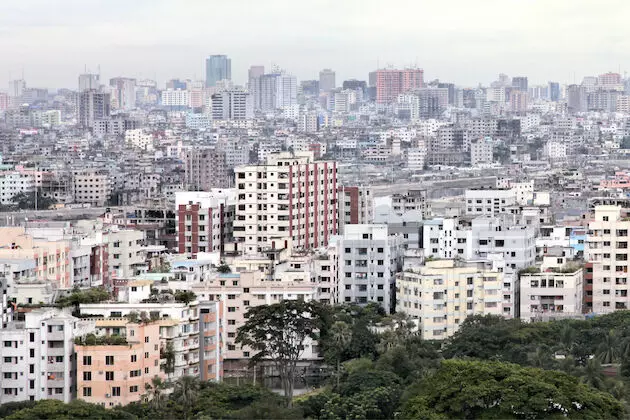
Dhaka, the capital city of Bangladesh, is a bustling metropolis known for its vibrant culture and dynamic economy. One of the most striking aspects of Dhaka is its staggering population density. With over 8 million crammed into just 306 square kilometers, Dhaka is one of the world’s most densely populated cities. It fosters a diverse and energetic atmosphere that drives economic growth and cultural exchange but is vulnerable to climate change-induced weather patterns. Dhaka, Bangladesh Credit: Mohammad Rakibul Hasan
Bangladesh is also experiencing increased extreme weather events such as heatwaves, cyclones, storms, and heavy rainfall. The frequency and intensity of these events have risen in recent years, causing widespread damage to infrastructure, homes, and agricultural land. The cyclone-prone coastal areas are particularly at risk. Climate change alters rainfall patterns in Bangladesh, leading to erratic monsoons and prolonged dry spells. These changes affect crop production, causing food insecurity for many. Additionally, altered river flows disrupt livelihoods dependent on fishing and agriculture. Agriculture is the backbone of Bangladesh’s economy, employing nearly half its workforce and contributing significantly to its GDP. Rising temperatures, changing rainfall patterns, and increased salinity in coastal areas reduce crop yields and make traditional farming practices unsustainable. This has far-reaching consequences for food security nationally and globally, as Bangladesh exports rice and other agricultural products.
Dhaka, the capital city of Bangladesh, a bustling metropolis known for its vibrant culture and dynamic economy, is also vulnerable to the impacts of climate change-induced weather patterns.
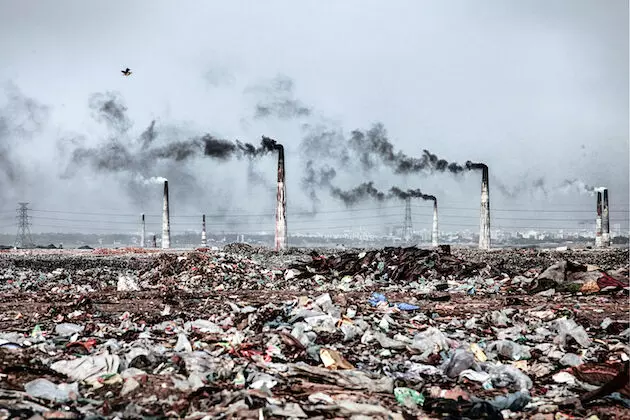
Dhaka City has significant infrastructural and environmental pressures, including traffic congestion and pollution, which the city grapples with daily. Climate change has added another layer of complexity to Dhaka’s demographic dynamics. Rising sea levels, more frequent cyclones, and erratic weather patterns have made life increasingly precarious in climate-prone areas of Bangladesh. As a result, a steady influx of people from these regions is migrating to Dhaka in search of employment opportunities. The city, already bursting at the seams, needs help accommodating this influx, leading to informal settlements and overburdened public services. This influx highlights the urgent need for sustainable urban planning, climate resilience, and job creation efforts in Dhaka to address the challenges posed by its population density and climate-induced migration. Dhaka, Bangladesh Credit: Mohammad Rakibul Hasan
A case study of Gabura, a union of Satkhira District, Bangladesh, adjacent to the Sundarbans, comprises twelve villages and an island near the mainland, the most vulnerable places in Bangladesh. It is home to more than 35 thousand people that was washed out by cyclone Aila in 2009. Hundreds of people, cattle, trees, and wild animals drowned and died in the water. Many people went to the nearest cyclone centers to survive, but many survived by climbing the trees or standing on the roofs of houses made of wood. Even after the cyclones, people were too poor to rebuild their homes and lived on the dams for over two years.
The study noted that along with the flood, the cyclone brought seawater that caused permanent salinity. Regular water sources were damaged, and crop fields created food insecurity. The land became barren, and trees couldn’t sustain themselves due to soil salinity.
Flooding also impacts the region. Because of the geographical setting, Bangladesh receives and drains a massive volume of upstream water. The flows of significant rivers originate from the Himalayas; due to the temperature rise, melting glaciers cause floods, and areas become waterlogged. Floodwaters seep into supplies used for drinking and washing, and latrines are washed away, allowing raw sewage to increase the threat of diseases such as cholera.
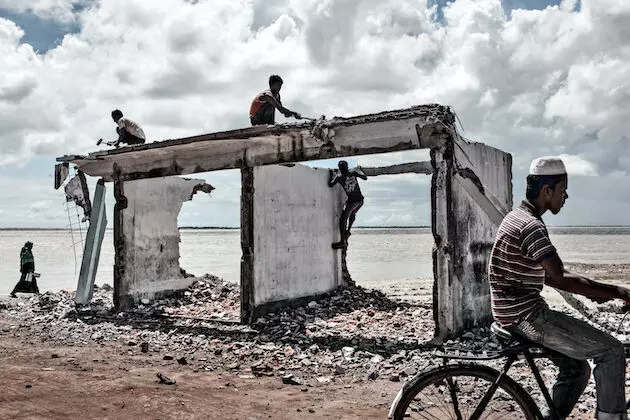
The Mawa area, situated in the Munshiganj district near Dhaka, Bangladesh, is grappling with a critical issue of river erosion. The region is flanked by several major rivers, including the Padma and the Arial Khan, which have been eroding their banks at an alarming rate. River erosion in this area has become a persistent threat, causing the loss of valuable agricultural land, homesteads, and infrastructure. This ongoing erosion has led to the displacement of many families who have seen their homes and livelihoods washed away by the relentless force of the rivers. Efforts to combat this issue often involve the construction of dams and other protective measures. Still, the battle against river erosion remains an ongoing and challenging struggle for the communities in the Mawa area. Addressing this problem requires comprehensive strategies that consider both short-term relief and long-term sustainable solutions to mitigate the devastating impact of river erosion on the region’s residents and their way of life. Mawa, Munshiganj, Bangladesh Credit: Mohammad Rakibul Hasan
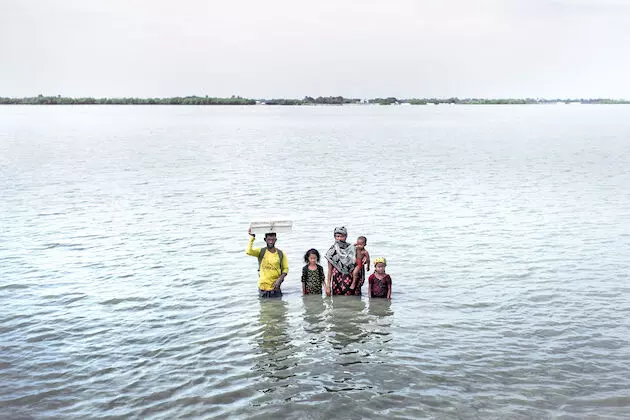
Climate migration from the Sundarbans area to major cities in Bangladesh, particularly Dhaka, has been a growing phenomenon driven by the adverse effects of climate change. The Sundarbans, a UNESCO World Heritage site and the world’s largest mangrove forest, faces rising sea levels, increased salinity, and more frequent cyclones due to climate change. As these environmental pressures intensify, many residents of this ecologically sensitive region are compelled to leave their homes for better opportunities and safety. Dhaka, the country’s economic hub, attracts a significant portion of these climate migrants. Satkhira, Bangladesh Credit: Mohammad Rakibul Hasan
Women in developing countries like Bangladesh mostly live in poverty and natural disasters. These are making them more vulnerable, affecting their livelihoods and security. In general, women are responsible for household work. The impact of climate change around coastline areas of Bangladesh has made women more prone to poverty.
The effect of climate change impacts indirectly on people, especially women and children.
Physical vulnerability may include death, injury, diseases, physical abuse, chronic malnutrition, and forced labor. Social vulnerability includes loss of parents and family, internal displacement, risk of being trafficked, loss of property and assets, and lack of educational opportunities.
Women contribute to both household maintenance and work in agriculture. “Up to 43% of rural women devote their time to aquaculture and agriculture, which are spheres likely to be affected by weather variability” (Hanifia et al. 2022), and when catastrophes hit either in rural coastal areas, income declines directly affect women’s agency, quality of their diet, and wealth and this in turn impacts the children.
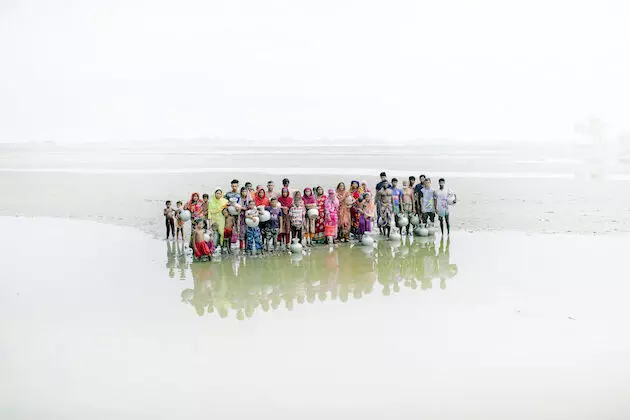
Southwestern Bangladesh grapples with a significant scarcity of safe drinking water. The region is prone to salinity intrusion due to its proximity to the Bay of Bengal, making the groundwater increasingly salty and undrinkable. This situation has dire consequences for the local population, as access to clean and safe drinking water is essential for human health and well-being. Many communities in Satkhira are forced to rely on rainwater harvesting systems and surface water, which can be contaminated, leading to waterborne diseases. Addressing the issue of safe drinking water scarcity in Satkhira requires innovative solutions, including desalination technologies and improved water management practices, to ensure that the residents have access to a vital resource for their daily lives. Satkhira, Bangladesh Credit: Mohammad Rakibul Hasan
Safe drinking water sources have become scarce in coastal areas because of groundwater salinity. Women and children must collect drinking water from distant places, and even many cases, they collect water crossing rivers. Frequent cyclone hits, food shortages, and inadequate water supply make women’s lives difficult, and as a result, school dropout rates and child marriage rates are high across the coastline. Malnourishment and diseases also impair learning. Extreme climate change-related disasters threaten school buildings and educational materials. For example, cyclones Sidr and Aila caused massive damage to school buildings and wiped out teaching materials around Sundarbans and its locality.
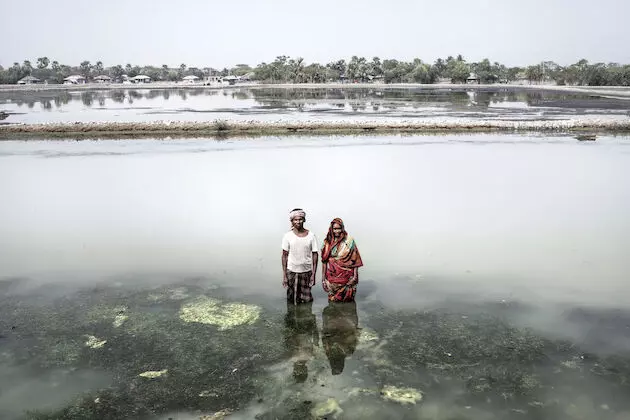
“When my husband, Ruhul Amin Seikh, goes fishing, I wait for him by the river’s edge. Some days, when I do not feel sick, I join him in our small boat. I can barely support my husband as I am aging and suffering from diseases. Our children are separated (from us). They have their families and are no longer able to provide for us. The forest is no longer providing us with food. After spending hours in the river, my husband returns with a few fish. We can hardly sell fish for 80 Taka (1 USD) daily. We starve or eat once (a day) as we grow older. Water is saltier than ever; our house is still broken after the cyclone, and now the coronavirus is killing us. We have almost no food for the coming days. We remain hungry; we remain thirsty.” – Fatema Khatun. Gabura, Satkhira, Bangladesh Credit: Mohammad Rakibul Hasan
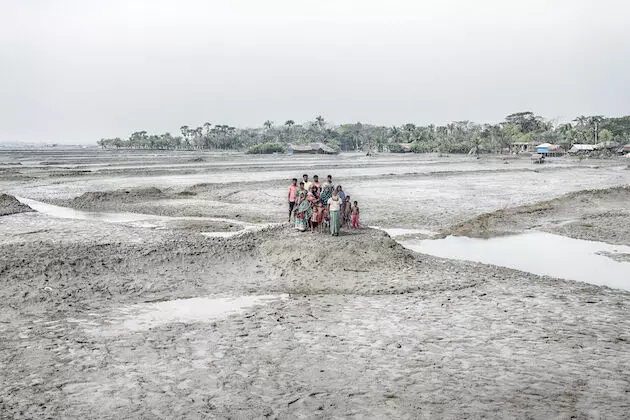
“We are left with one bucket of rice and some vegetables for our 21 family members. Since the virus hit, we are no longer allowed to go fishing. In the last seven months, I entered the jungle for only seven days. My sons are trying to work as laborers now. But there is very little work now. Our lands went into the river, and with every passing year, calamities are hitting us hard. There is little drinkable water left in the area, and now the devastation of this pandemic is going to kill us with the scarcity of food. Our children are hungry all the time. When again will we be able to eat a proper meal? We do not have any idea.”– Motiar Rahman Gazi, 60 years old, has a big family to feed. But the pandemic hit this already vulnerable family in Ahsasuni at the Bay of Bengal hard. The river has flooded their land, and now their survival depends on the other work they can find for a living. The scientists forecasted that the whole coastal belt of Bangladesh around the Sundarbans will be under seawater by 2050. Credit: Mohammad Rakibul Hasan
The coastal areas of Bangladesh have completely different geophysical features from the other parts of the country. It also has socio-political patterns that are not seen in the rest of the country, which elevates risks and vulnerabilities of the people who live across the coastline territories.
The coastline brings challenges for earning income. Thus, the poverty margin accelerates many risks and human security factors immediately impacting its inhabitants, as do frequent natural catastrophes.
“A vast river network, a dynamic estuarine system, and a drainage basin intersect the coastal zone, which made coastal ecosystem as a potential source of natural resources, diversified fauna, and flora composition, though there also have an immense risk of natural disasters,” Shamsuddoha and Chowdhury (2007) noted.
Every year people are displaced from the coastal areas of Sundarbans. The tidal floods and cyclones bring seawater to destroy sweet water sources such as ponds, rivers, and land groundwater. Over the last two decades, the increase in salinity has been high. Paddy and various vegetable fields have failed, and this has resulted in food scarcity exacerbating many diseases. The International Centre for Diarrheal Disease Research Bangladesh (ICDDRB) researchers have noticed an alarmingly high rate of miscarriages in the small village of Chakaria, near Cox’s Bazaar, on the east coast of Bangladesh (Haider, 2019). Studies and research on the other part of the coastal areas around Sundarbans on fertility and uterus cancer that may be linked to climate change and salinity rise are underway because there is evidence that consuming saline water harms the skin, menstruation, and, more seriously, unborn children.
The Asian Disaster Reduction Center (ADRC) reports have indicated the increasing ferocity of weather patterns throughout the years, documenting the environmental and social impacts of each disaster.
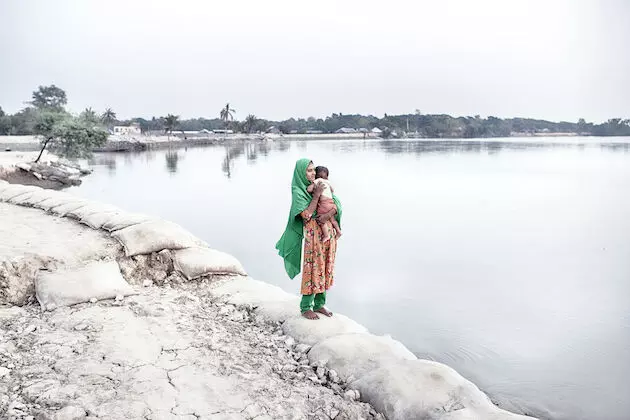
“After eleven days of cyclone Amphan, my daughter was born. We had no electricity, no food, and no drop of drinking water. My husband could not go fishing in the river because of the lockdown in coronavirus. Since then, my husband could hardly manage permission to enter the jungle. I got married when I was 15 in the aftermath of another cyclone. Every year, at least twice, our house has been destroyed in cyclones, tornados, or storms. We suffered terribly from drinking water as every year salinity is increasing. Now, my husband and I eat once daily. During the lockdown, I hardly ate as there was no food. My youngest child is now six months old; she is severely underweight. What could we do? I must first give food to my father-in-law and mother-in-law, who are in their nineties. And then I feed our children; if we have something left, my husband and I will have it. There is nothing in our food storage. Today, we only have one kilogram of rice, a few onions, garlic, and vegetable leaves. I have nothing to cook tomorrow.” – Marzina Begum. Satkhira, Bangladesh Credit: Mohammad Rakibul Hasan
People around coastlines near Sundarbans constantly search for food, catching excessively young shrimps from rivers and degrading the marine ecology and biodiversity. As the places around coastlines are affected by salinity due to climate change, people’s usual professions are replaced by alternatives to survive in hostile conditions. Due to the lack of work opportunities, women have no choice but to catch baby shrimp from coastal rivers; they sell them in the local market. A significant number of agents work for big shrimp firms that buy undersized shrimps.
Fishing communities in Bangladesh report that the availability of many local species has declined with riverbeds’ silting up, temperature changes, and earlier flooding. Communities are coping by selling labor, migrating, and borrowing money from lenders. The unemployment rate has increased as local peasants lose their jobs due to the scarcity of agricultural land. Shrimp farming needs much less labor than agriculture. As a result, many migrate to wealthier areas, while others depend on Sundarbans’ forest resources.
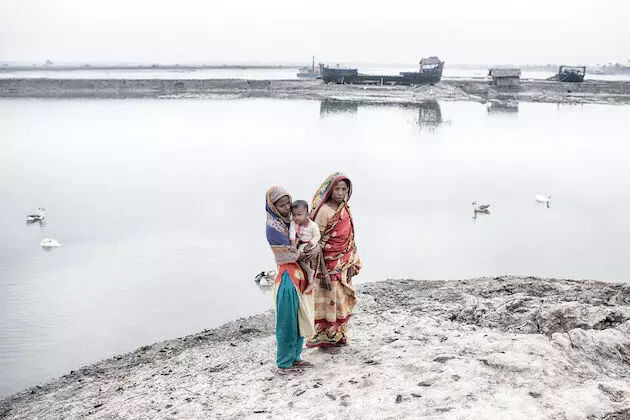
“I am the only earning member of my family. My husband left me. I live with my mother, who is in her sixties and cannot walk properly. We lost our home during cyclone Bulbul. Since then, we have been sheltering in a temporary house made of a Gol leaf for over a year. When six months ago cyclone Amphan hit, I thought of fleeing our village. If I catch fish, we will eat. Since corona, there is a restriction, and we cannot enter the forest like before. My family has nothing to eat tomorrow. We are just surviving with little or no food.” – Fatima Banu. Satkhira, Bangladesh Credit: Mohammad Rakibul Hasan
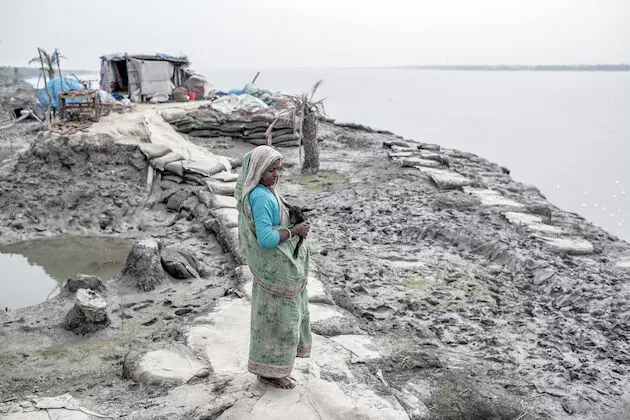
“Six months ago, during cyclone Amphan, I lost all domestic cattle. Since then, I have continued living in our wrecked house all alone. My children have left for the city to find a job. They could not manage to come (back) since the lockdown. I started to raise animals again and protect them all the time. The river is coming close; I might lose my destroyed home someday. I used to work at people’s houses in return for food. When I could not assist with any household chores, I went fishing. There is no work in this locality; we hardly catch fish. I have little left to eat. How am I going to survive with so much struggle? I do not know.” – Helena Begum. Satkhira, Bangladesh Credit: Mohammad Rakibul Hasan
The government has invested in constructing cyclone shelters and early warning systems, reducing the loss of life during cyclones and storms. Efforts are underway to promote climate-resilient agricultural practices, including developing drought-resistant crop varieties and better water management. Expanding access to renewable energy sources, such as solar power, in rural areas reduces the pressure on traditional biomass fuels, mitigating deforestation minimizes the stress on conventional biomass fuels and mitigates.
Bangladesh has sought international support and partnerships to fund and implement climate adaptation projects, including efforts to protect coastal areas from sea-level rise. The country’s efforts to adapt and mitigate the impacts of climate change are commendable, but the scale of the problem requires sustained international cooperation and support. The world must recognize that Bangladesh is not alone in this battle; the consequences of climate change here are harbingers of what may come in other vulnerable regions if global action is not taken promptly. To protect this beautiful nation and its people, we must act decisively to reduce greenhouse gas emissions and support those on the front lines of climate change, like Bangladesh.
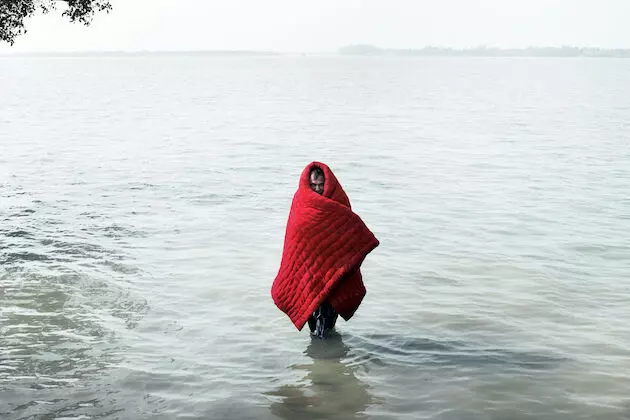
Bangladesh is highly vulnerable to its adverse effects. The key challenges are rising sea levels, increased salinity in coastal areas, more frequent cyclones, and erratic rainfall patterns. These impacts lead to displacement, food and water scarcity, and significant economic losses, especially in agriculture and fisheries. Bangladesh actively pursues climate adaptation and mitigation strategies to mitigate these effects and build resilience. However, the road ahead remains challenging as the country grapples with climate change’s consequences. It underscores the urgent need for global cooperation to combat climate change and support vulnerable nations like Bangladesh to adapt to this rapidly evolving environmental crisis. Satkhira, Bangladesh Credit: Mohammad Rakibul Hasan
Cover Photograph:Gabura Union, situated in the southwestern region of Bangladesh near the Sundarbans Mangrove Forest, faces a dire threat as scientists predict that it could be submerged by the year 2025 due to the impacts of climate change. This area, characterized by low-lying coastal terrain, is exceptionally vulnerable to sea-level rise and storm surges. The rising sea levels, exacerbated by global warming, have already resulted in significant land erosion and the displacement of local communities. According to scientific studies and reports, including those from the Intergovernmental Panel on Climate Change (IPCC), the situation in Gabura Union is dire, and urgent measures are required to mitigate the impending crisis. Efforts to combat this issue include the construction of protective barriers and the promoting of climate-resilient practices, but the challenge remains substantial. The plight of the Gabura Union is a stark reminder of the profound and devastating impacts of climate change, particularly in coastal regions. It underscores the urgency of global efforts to mitigate its effects. Gabura, Satkhira, Bangladesh Credit: Mohammad Rakibul Hasan,.
Mohammad Rakibul Hasan is a documentary photographer/filmmaker and visual artist. He was nominated for many international awards and won hundreds of photographic competitions worldwide, including the Lucie Award, the Oscar of Photography, the Human Rights Press Award, and the Allard Prize. His photographs have been published and exhibited internationally. He is based in Dhaka, Bangladesh.
Inter Press Service.



